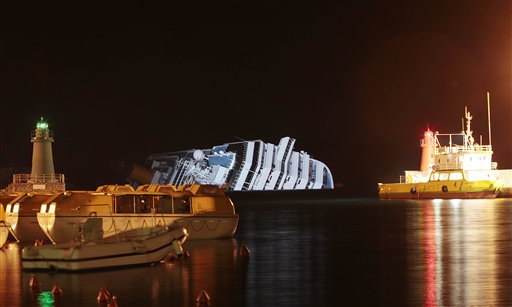Costa Concordia cruise liner crash a costly, memorable mishap at sea
Friday, January 1, 1904
The year is barely a fortnight old, but it is fairly safe to assume that pictures of a massive cruise liner on its side on rocks in shallow waters near a small Italian island on Friday night will be among 2012's most remembered. They will be recalled for the thankfully small loss of life -- six dead so far -- in the disaster, for the high drama involved and for the short and long-term costs the wreck likely will have on the global cruise industry.
For the moment, the effort to find the missing, including two Americans, is paramount. Experts, though, say that the chance any individuals would be found alive after three days are slim. Still, the search, as it must, continues.
The rescue effort was halted for a while Monday as seas roughened. Choppy waters and slight shifting of the liner on the submerged rocks on which it foundered, officials feared, could endanger divers and cause the 500,000 gallons of fuel aboard to leak. The latter would threaten nearby coastlines and waters that are a protected sanctuary for sealife. The sea did calm late Monday, and rescuers returned to the ship. Plans to offload fuel and to salvage the ship continued.
Accounts of the dramatic wreck and its aftermath have caused alarm around the globe. Questions about the conduct of the captain and crew of the Costa Concordia abound. Some accounts indicate that the now-jailed captain left the ship before passengers, a violation of both Italian law and the code of the sea.
There are reports, too, that the captain purposefully deviated from his prescribed course before the ship came to grief. A spokesman for the Costa line, a division of Carnival Corp., seemed to agree, saying that the captain had violated "written rules of conduct." It will take time to determine the sequence of events that lead to the shipwreck and to assign blame, if, indeed, there is blame to be assigned.
There's no need to wait to tally the likely costs of the mishap. One price -- the loss of life -- is immeasurable; other costs are easier to determine. They will be high.
The ship's insurers likely will pay out between $600 million and $800 million. If so, that would make it the world's costliest maritime disaster, exceeding the $500 million paid out after the Exxon Valdez disaster off Alaska in 1989. Additional costs, especially if environmental issues related to fuel leaks arise, could significantly increase the projected total.
Friday's event will harm an industry that thrives on positive publicity. The disaster likely will slow bookings. Carnival projects a loss of about a $100 million this year as a result of the disaster. Other cruise lines will be hurt by association. That will be a hard blow to an industry struggling to restore profitably since a poor global economy reduced leisure travel. Cruise lines will have to work diligently to restore confidence in their industry,
Millions who just a few days ago might have considered a vacation cruise will now think twice about doing so. The vivid pictures of the Concordia will be the cause.

